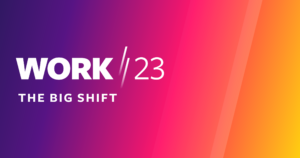Flexible and Effective: Leadership Strategies for the Hybrid Workplace
A presenter at MIT SMR’s symposium on the future of work answers attendees’ questions about how to effectively build an organization with both in-person and offsite employees.
Topics
Work/23: The Big Shift

Many leaders don’t know how to manage work based on outcomes versus the proverbial “bums in seats” — tracking who is at the office and for how long. But it’s possible to have a high-performing, healthy workplace culture in a hybrid workplace, with flexibility in when and where people work. It just needs to be managed differently.
That was the message of Future Forum’s Brian Elliott, who presented on a panel with N. Sharon Hill of the George Washington University School of Business and Julie Dervin of Atlassian during Work/23, an MIT Sloan Management Review symposium held in May 2023.
Elliott said that 93% of the 10,243 knowledge workers his company polled said they want flexibility in when they work. Those who were given some choice, he said, had productivity scores 39% higher than those who were not. Those with some flexibility about where they work also scored higher (8%).
Email Updates on the Future of Work
Monthly research-based updates on what the future of work means for your workplace, teams, and culture.
Please enter a valid email address
Thank you for signing up
Finding an equilibrium between employees’ desire for flexibility and an organization’s strategic goals requires a reexamination of the kinds of work that need to be done in person. It also may require different work configurations for different groups within the same organization, and it certainly requires different ways of benchmarking the work employees accomplish.
Attendees had more questions for the presenters than there was time for, and Elliott agreed to answer some after the event. (Questions and answers have been lightly edited for clarity.)
How do you measure productivity? Most workers say they are more productive working from home and on their own schedule, but are they really?
Here’s a heretical take: We need to stop trying to measure productivity in knowledge work and focus all that time and energy on measuring outcomes.
Productivity metrics take outputs (emails sent, cases closed) and divide them by inputs (hours active), and the better ones adjust for quality (cases reopened). That can work, somewhat, for rote, routine tasks, which are what get automated over time. But also, those metrics can be gamed, and people will game them — up to and including buying mouse jigglers. As Dominic Price of Atlassian has written, “Productivity has always been a good way to measure the impact of machines and capital. It’s just never been a good way to measure the impact of humans.�

